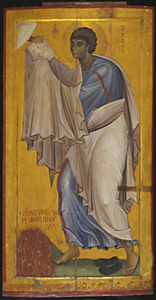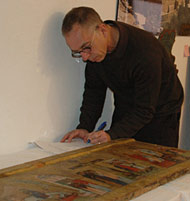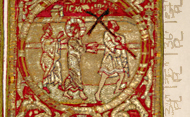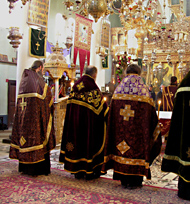 |
 |
Saint Catherine's Monastery lies in a remote region of Egypt at the foot of Mount Sinai, on the site where Moses is believed to have seen the Burning Bush.
Photography by Bruce M. White, 2005 |
|
 |
Many of the 52 precious objects in the exhibition Holy Image, Hallowed Ground: Icons from Sinai left their home at the Holy Monastery of Saint Catherine, the world's oldest continuously operating monastery, for the first time. Over a year of preparation, conservation work, and careful planning went into this logistical feat.
Conservators and curators from the J. Paul Getty Museum worked with the monks of Saint Catherine's to devise innovative ways to protect these treasures on their nearly 8,000-mile journey to Los Angeles.
The planning involved careful documentation; close collaboration between the monks, conservators, and preparators; and the building of tailor-made crates and display cases that protect against bumps and vibrations as well as small changes in humidity.
Many of the objects traveled from Sinai for the first time for this exhibition. The icons are painted on wooden panels, which expand and contract with changing humidity. Because they have adapted to the dry desert climate over the centuries, they are especially sensitive to changes in humidity. Sinai is extremely dry, with relative humidity inside the monastery rarely exceeding 30 percent. Los Angeles, although it is located on the edge of a desert, has an average humidity between 65 and 79 percent. Because of this extreme change, Getty conservators took unprecedented measures to keep the objects from Sinai in a stable climate during transport and while they are on display at the Getty Center.
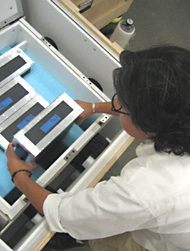 |
 |
Shipping crates were custom built to carry the objects traveling from Sinai. Each double crate is composed of over 25 layers of materials that provide shock absorption and minimize changes in temperature and humidity. |
|
 |
So how do they do it?
First, conservators and preparators built special shipping crates for each object. Each crate is composed of more than 25 layers of materials, which provided shock absorption and humidity control while the objects were in transit. Objects have their own cases, which are then placed in a wooden crate. Each crate is then suspended within a second crate, with a layer of air and cylinders made from a special visco-elastic polymer—called Sorbothane—in between them to provide maximum shock absorption. Other layers include various types of foam for insulation and cushioning, aluminum laminate to seal the wood, thermic tape to create a humidity and temperature barrier, and silicon to seal corner joints against humidity.
Second, the Getty's facilities staff used dehumidifiers to temporarily reduce the relative humidity in the Exhibitions Pavilion at the Getty Center during the two-week installation period. Once the objects were removed from their shipping crates and installed in climate-controlled display cases, the relative humidity in the room was returned to the usual 50–55 percent level.
Finally, Getty preparators designed and built climate-controlled display cases for each of the 52 objects. Hidden silica gel packs absorb the moisture from the air in order to keep the humidity within the cases at 27–32 percent humidity. Computerized data loggers in individual cases also take constant humidity readings.
Ready to go? Not quite. Before the artworks could begin the journey, their pre-move condition was recorded in minute detail.
Because many of these objects show signs of their use as ritual objects over hundreds of years, it was important to document their condition before they were moved. This documentation ensured that the objects arrived at the Getty Center in the same condition that they left Sinai. Conservators and preparators traveled to Sinai to study the objects and draw up condition reports, which were kept with the artworks during transit.
Staff working in Sinai took detailed measurements of the objects and sent them back to the Getty Center, where preparators and mountmakers created the custom crates and the mounts for the exhibition.
The art from Saint Catherine's also had special couriers. When valuable artwork travels, it always takes along one or more traveling partners—chaperones, if you will. Couriers from the lending museum travel with the artwork, watching it from the moment it leaves home to the moment it is installed in the galleries of the borrowing museum. But while most couriers go home when the artwork is delivered, monks from Saint Catherine's will stay in Los Angeles for the duration of the exhibition. They are seen in the galleries, overseeing the holy objects that are in their charge.
The monks' presence serves to remind us that these objects are not only art objects, but a living part of the practice of Eastern Orthodox Christianity.
These holy objects have made this journey so that many thousands of people in Los Angeles can experience a little bit of the mystery of Saint Catherine's without making the long journey to this remote monastery. The exhibition at the Getty Center is a rare opportunity to see these centuries-old objects. Once the exhibition is over, conservators, curators, and preparators will repeat many of these steps to return the objects back to their home in the Sinai desert where they may remain for centuries before traveling again.
Read the press release about this exhibition.
|

